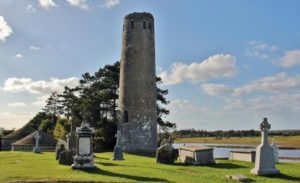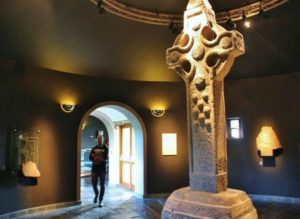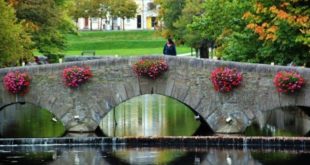Before making my first trip through the rural world and landscapes of Ireland, beyond what was my first contact with the country, with a first trip to Dublin, I could not imagine visiting that country and not see the Celtic crosses .
What better place to do it than an enclave as magical as Clonmacnoise , an essential stage in your journey from the aforementioned Dublin to the west of the island to travel along the Atlantic coast route .
Can you imagine a place that goes back to the Paleochristian era , specifically, in the middle of the 6th century, where hundreds of sepulchers with Celtic crosses extend, dating from the 8th and 12th centuries. with the archaeological remains of several temples and a small cathedral ?
That is Clonmacnoise .

Located almost in the geographic center of the island of Ireland, in the county of Offaly , on the banks of the river Shannon , history says that the abbey and the monastic cluster of Clonmacnoise were founded in the year 548 by San Ciarano .
It was the time of the barbarian invasions and Saint Patrick a century earlier had already established the Catholic Church in Ireland.
With the foundation of a monastery like that of Clonmacnoise , the pagan tradition of the Druids was collected and a center of power was created that became a small city populated by the Celts.
The monks spread the new Catholic religion, but without a hierarchical relationship with Rome.

San Ciarano died just one year after the foundation of the monastery, but since he was buried in that place, for 1,500 years it has become a place of pilgrimage.
Visit of Clonmacnoise
What will you see now in your visit of Clonmacnoise ?
It will give you the feeling of being in a big cemetery, and that’s the way it is, because the first thing that will get your attention is the big Celtic crosseslocated in front of the remains of what was a small cathedral whose origin dates back to the year 909, and the stone remains of some buildings, remnants of what was a small city with several temples.

Of course, the entire enclave is presided over by a large circular stone tower17 meters high.
Built in the year 1124, it is a medieval tower typical of Ireland , a mix of bell tower and defensive place, where you will be surprised to see that the entrance to it is at a certain height.
If what has taken you to Clonmacnoise is to see the Celtic stone crosses , the most important one is right in front of the aforementioned cathedral .
Celtic crosses in Clonmacnoise
Known as the Cross of the Scriptures , it was built around the year 900 on a single block of sandstone. With four meters of height, you can see various inscriptions, as well as scenes of the Cruxifición or the Final Judgment .

I will make the reservation that it is a replica because the original cross can be seen in the small museum of the Visitors Center , to be preserved from the inclemency of the weather.
Among the Celtic crosses also stands out the so-called Cruz Sur , 3.7 meters high, which shows an ornamental decoration with abstract forms.
The denominated cathedral of Clonmacnoise was constructed in the year 909, and they are the rest with greater dimension of which you can see in the place, and what better it is conserved of the original building is the North wall.

Of course, on the west facade, originally from the year 1200, you can cross through a door mixing Romanesque and Gothic style.
The tomb of the saint is in the smallest of the temples, barely four meters long, which is known as the Temple of Ciaran .
The rest of the other temples of Clonmacnoise are also of the same time, of around the year 1200, although they had remodelations in the later centuries.

Your Clonmacnoise visit must be completed by visiting the aforementioned Museum of the Visitors Center , especially to see the original Cross of the Scriptures .
 Countries To Travel Travel Tips and Plans
Countries To Travel Travel Tips and Plans


